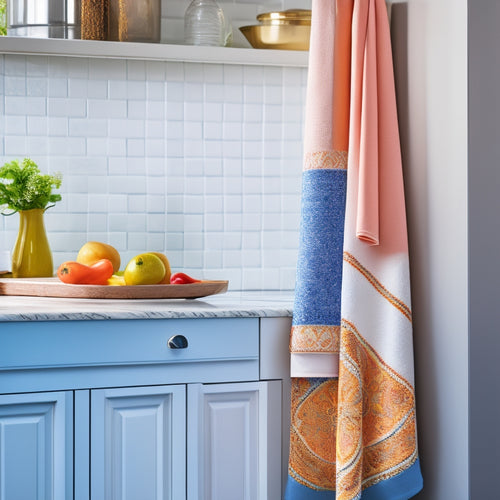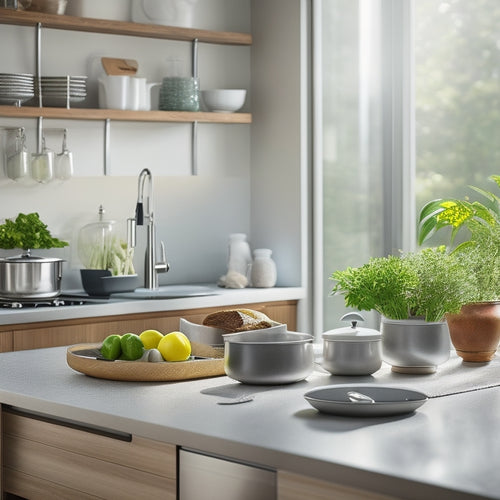
5 Best Kitchen Storage Solutions for Gluten-Free Cooking
Share
You're about to revolutionize your kitchen with tailored storage solutions that cater specifically to your gluten-free cooking needs. Start by designating a specific zone for gluten-free staples and separating gluten zones in the kitchen. Use airtight containers to preserve freshness and prevent cross-contamination. Allocate space for gluten-free flours with stackable containers and flour canisters. Install under-counter pull-out appliance garages to keep countertops clutter-free. Finally, utilize cabinet appliance racks for smaller appliances. With these solutions, you'll be well on your way to a gluten-free kitchen that's organized, efficient, and ready to cook up a storm - and there's more to discover.
Key Takeaways
• Designate a specific gluten-free zone in your pantry with stackable containers and labels for easy accessibility and visibility.
• Use airtight containers to preserve freshness, prevent spoilage, and avoid cross-contamination with gluten.
• Allocate space for gluten-free flours with dedicated stackable containers, flour canisters, or sliding drawer organizers.
• Implement hidden storage solutions like under-counter pull-out appliance garages or cabinet appliance racks for special gluten-free appliances.
• Label and separate gluten zones in the kitchen with clear labels and storage solutions to maintain organization and safety.
Gluten-Free Pantry Organization Tips
To maximize your gluten-free cooking experience, start by designating a specific zone in your pantry for gluten-free staples, ensuring that cross-contamination risks are minimized and meal prep becomes a whole lot easier. This zone should be easily accessible and visible, so you can quickly grab what you need when cooking.
When organizing your gluten-free pantry, think vertically to maximize shelf space. Install shelves or use stackable containers to store items like gluten-free flours, baking supplies, and snacks. Label each shelf or container so you can quickly find what you need.
Don't forget to organize your spices! Use a spice rack or a small container with dividers to keep your gluten-free spices separate from the rest. This will prevent cross-contamination and make cooking a breeze.
Labeling and Separating Gluten Zones
Frequently, gluten-free cooks find that labeling and separating gluten zones is an essential step in maintaining a safe and organized kitchen space. This pivotal step helps prevent cross contamination, ensuring the well-being of those with gluten intolerance or sensitivity.
To achieve this, you'll need to designate dedicated gluten-free zones within your kitchen. Start by identifying areas where gluten-containing ingredients will be stored and prepared, and label them clearly. Then, create separate zones for gluten-free ingredients and cooking surfaces. Implementing organizing strategies, such as color-coding labels or using separate utensils and equipment, will help you maintain these zones effectively.
Consider investing in storage solutions like bins, baskets, or shelves with clear labels to keep gluten-free ingredients organized and easily accessible. By separating and labeling gluten zones, you'll be able to efficiently navigate your kitchen while minimizing the risk of cross contamination.
This thoughtful approach will help you provide safe and delicious meals for those who rely on gluten-free cooking.
Airtight Containers for Freshness
You'll find that using airtight containers is a game-changer for preserving the freshness of your gluten-free ingredients, ensuring they stay potent and flavorful for a longer duration. By storing your ingredients in airtight containers, you'll reap several benefits. For one, they keep air, moisture, and light out, which can cause ingredients to spoil or lose their potency. Airtight containers also prevent cross-contamination with gluten, which is essential for those with gluten intolerance or sensitivity.
When it comes to proper storage techniques, make sure to store your airtight containers in a cool, dry place, away from direct sunlight. You should also label each container with its contents and the date it was stored, so you can easily keep track of what you have and how long it's been stored.
Additionally, consider storing your most frequently used ingredients in easy-to-access locations, while less frequently used ingredients can be stored in harder-to-reach areas. By following these simple tips, you'll be able to keep your gluten-free ingredients fresh for a longer duration, ensuring you can serve delicious and safe meals to your loved ones.
Allocating Space for Gluten-Free Flours
Since gluten-free flours are a staple in your pantry, it's essential to dedicate a specific area for them, ensuring they remain organized, easily accessible, and protected from cross-contamination. By doing so, you'll save time and reduce the risk of mixing flours, which can affect the quality of your baked goods.
Here are some creative storage ideas for your gluten-free flours:
| Storage Option | Benefits |
|---|---|
| Stackable containers | Space-saving, easy to label, and accessible |
| Flour canisters | Attractive, airtight, and keeps flours fresh |
| Sliding drawer organizer | Convenient, adjustable, and customizable |
| Hanging flour bags | Easy to store, takes up minimal space, and visible |
| Under-sink storage | Utilizes dead space, out of the way, and convenient |
When planning your flour organization, consider the 'golden zone' in your kitchen, where you can easily access your flours without having to bend or stretch. This will make your gluten-free cooking experience more enjoyable and efficient. By allocating a specific space for your gluten-free flours, you'll be able to keep them organized, fresh, and within reach, making it easier to serve delicious gluten-free meals to your loved ones.
Hidden Storage for Special Appliances
How do you keep your special gluten-free appliances, like stand mixers and bread machines, out of sight yet still easily accessible when you need them? You want to keep your kitchen countertops clutter-free, but you also need to make sure that your appliances are easy to retrieve when it's time to whip up a gluten-free masterpiece.
One solution is to install an under-counter, pull-out appliance garage. This clever storage solution allows you to tuck away your appliances when not in use, keeping your countertops clear. When you need to use them, simply pull out the drawer and voilà! Your appliance is ready to go.
Another option is to utilize a cabinet appliance rack. This is especially useful for smaller appliances like toasters or blenders. By storing them in a cabinet, you can keep them dust-free and out of the way, while still having easy access when you need them.
Frequently Asked Questions
How Do I Store Gluten-Free Grains to Maintain Their Nutritional Value?
"You're on a mission to preserve the goodness of gluten-free grains, and you're wondering... how do you keep them fresh? The secret lies in proper storage, where airtight containers and cool, dark places are your best friends for nutritional preservation."
Can I Use Second-Hand Containers for Gluten-Free Food Storage?
'When using second-hand containers for gluten-free food storage, you're taking a risk - guarantee container safety by thoroughly cleaning and sanitizing them, and implement a labeling system to avoid cross contamination risks.'
Are Glass or Plastic Containers Better for Storing Gluten-Free Products?
You're maneuvering the storage landscape like a pro, and now you're wondering if glass or plastic containers are better for storing gluten-free products. Opt for glass for airtight, long-term storage, or plastic for stackable, short-term solutions.
How Often Should I Clean and Sanitize My Gluten-Free Storage Containers?
You should clean and sanitize your gluten-free storage containers every 1-2 weeks, depending on usage, and after each use if you notice crumbs or spills.
Can I Store Gluten-Free and Gluten-Containing Foods in the Same Pantry?
You're wondering if you can store gluten-free and gluten-containing foods in the same pantry, but beware: cross-contamination risks lurk. Implement safe storage practices like separate shelves, a labeling system, and meticulous pantry organization to guarantee a safe haven for gluten-free eats.
Related Posts
-

Top-Rated Dish Drainers for Kitchen Use
Top-rated dish drainers enhance your kitchen's efficiency and aesthetics. You'll find compact designs that save preci...
-

Over-The-Door Kitchen Towel Holder
An over-the-door kitchen towel holder is a smart way to maximize your space while keeping towels easy to grab. It hoo...
-

Dish Drainer Options for Kitchen Islands
When selecting dish drainers for your kitchen island, consider options that maximize space and enhance workflow. Comp...


